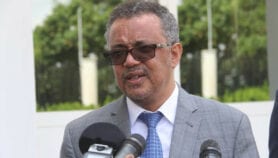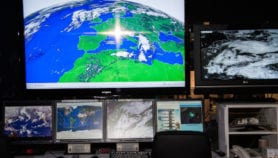Send to a friend
The details you provide on this page will not be used to send unsolicited email, and will not be sold to a 3rd party. See privacy policy.
As the powerful memories begin to fade of the tsunami that swept across the Indian Ocean on 26 December 2004, some myths surrounding the disaster seem to be becoming increasingly-widely accepted. One of them, frequently repeated by governments and aid donors alike, is that countries affected were caught by surprise.
That isn’t quite true. The killer waves originating near Indonesia’s Sumatra island may have sped across the Indian Ocean at the speed of a jetliner. And the alert about the impending tsunami may have moved at the speed of light through the Internet. But there were few listeners at the receiving end.
Scientists at the Pacific Tsunami Warning Centre in Hawaii, United States, who had monitored the extraordinary seismic activity, issued a tsunami warning within an hour of the undersea earthquake that caused it being detected. That was too late for Indonesia, which was already hit. But it could have made a big difference in countries further away, such as India, Sri Lanka and Thailand.
Who was listening?
One year later, it’s still not clear exactly who in Sri Lanka had access to that warning as public officials don’t own up to the responsibility. But a stark fact remains: no one reacted with the swiftness that such information warranted.
The entire Sri Lankan government was on holiday. When journalists pointed this out a few days later, the then science minister, himself a scientist, responded with the blithe remark: ‘Do journalists work on holidays?’
What else but the holiday mood can explain another fact? As the tsunami progressively pounded the teardrop-shaped island over a four-hour period — starting at 8.30 that Sunday morning — news did not travel internally either.
If only eastern Sri Lanka, which was hit first, had alerted the rest of the island, coastal evacuation could have significantly reduced a death toll that totalled nearly 40,000 (including missing persons). So much for information and communications technologies!
Elsewhere in the tsunami-hit region, government officials chose to suppress the warning for various reasons. Thailand, for example, didn’t want a possible false alarm to affect its thriving tourist industry.
A role for technology
When Asian governments now talk in eager terms about setting up the most advanced tsunami warning system in the Indian Ocean, I cannot help thinking: these are the very people who did nothing with the timely warning they did receive about the 2004 tsunami. How can sophisticated technology change this mindset — the hallmark of weak leadership?
And in a region that gets battered by a multitude of weather extremes and disasters, why focus only on tsunamis? Surely, we need all-hazard warning systems?
Don’t get me wrong: developing effective early warning systems for multiple hazards is an urgent priority for the Indian Ocean rim countries. But setting up a state-of-the-art, high-tech (and high cost) system is not a solution by itself. It’s only the first step.
The most advanced early warning system in the world can only do half the job: they can alert governments and other centres of power (e.g. military) of an impending disaster. The far bigger challenge is to disseminate that warning to large numbers of people spread across vast areas in the shortest possible time.
This is precisely what wasn’t done on 26 December 2004 (see Tsunami disaster: a failure in science communication).
During the past year, policymakers and experts have come together — under the umbrella of the United Nations — to discuss ‘modalities’ of an Indian Ocean early warning system.
But — unless it’s buried deep in the volumes of technocratic babble that these meetings generated — I can’t find a clear strategy on how Asia’s wielders of power will actually handle the dissemination of a warning in a timely, effective and credible manner.
In short, how will they go that all-important ‘last mile’?
 |
|
The 2004 tsunami devastated coastal communities |
Tapping the mass media
Some countries have started setting up loudspeakers and sirens. These can work for densely populated coastal areas — such as cities and popular beaches. But they can’t work for tens of thousands of kilometres of coastline. When it comes to life-saving information, everyone must have the same level of access, no matter where they live.
There is one smart, ready-made solution. In the past 15 years, Asia’s airwaves have become crowded with a cacophony of FM radio and television channels that reach out to most households day and night. They inform, titillate and occasionally educate Asia’s billions.
A well coordinated, collaborative plan should be able to tap the mass media’s unparalleled outreach in times of impending crisis.
Partnerships with the media will be key in traversing that last mile. This is a challenge for Asian governments, more accustomed to legislating and regulating than forming public-private partnerships.
An even bigger challenge is to ensure the credibility of such a system. Whether it’s SARS, bird flu, HIV/AIDS or a tsunami, many Asian governments have an appalling track record in managing public information and communication in times of crisis. When denial, suppression and under-statement don’t work, the catch-all cover of ‘national security’ is invoked — usually to cover up official bungling.
Sadly, scientists working in taxpayer funded government institutions are often part of this cover-up — and there are too few whistle-blowers around. No amount of space age technology, ICTs or donor millions can fill this credibility gap.
The last mile
Living and working in Sri Lanka, I would tend to believe a trusted friend more than my own government. If they are serious about our individual safety and security, our governments have to try much harder to become our trusted friends.
One indication that we haven’t really learnt from the deadly tsunami came on 28 March 2005, when another undersea earthquake off Sumatra triggered a tsunami alert in the Indian Ocean. It turned out to be a false alarm. But while it lasted, the Sri Lankan government did too little, too late: no one in authority was willing to take the responsibility for issuing a warning. This time the government was not on holiday — it was just sleeping at the wheel.
Our so-called public media received the information within minutes. But they also dithered, unwilling to be the first to break the news. In desperation, some public-spirited individuals and NGOs used whatever private means they could muster — including mobile phones and privately owned media channels — to warn as many coastal communities as they could reach.
As we later learned, other tsunami-affected Asian countries had managed this false alarm a bit better. But if I were a coastal dweller anywhere on the Indian Ocean rim, I won’t place my family’s safety in the hands of unfeeling governments, complicit scientists or incompetent officials.
That last mile is going to be a very long one indeed.
Nalaka Gunawardene is a Sri Lankan science writer who covers ICTs, media and development issues.













